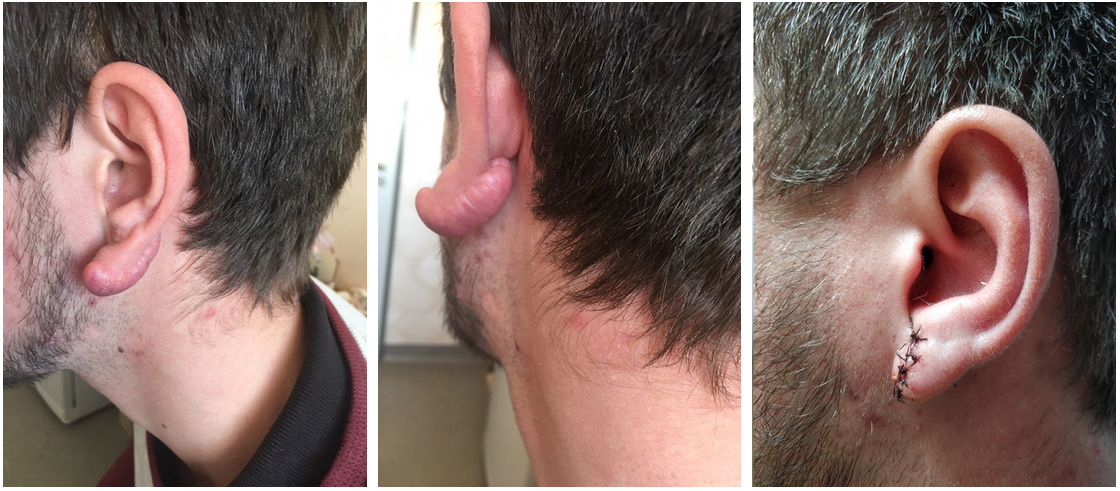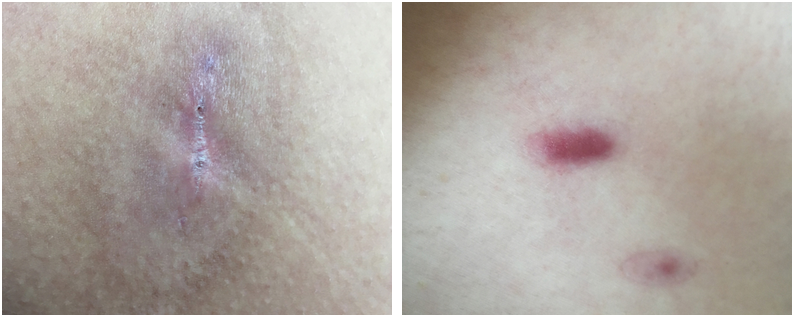Pathological scars In violation of the integrity of the skin as a result of injuries (cuts, abrasions, deep scratches, animal bites), inflammation (boils, acne, etc.), burns or cosmetic
Pathological scars
In case of violation of the integrity of the skin as a result of injuries (cuts, abrasions, deep scratches, animal bites), inflammation (furuncles, acne, etc.), burns or cosmetic manipulations (piercings of the earlobes, tattoos) and surgical interventions, scars (scars) are formed. The wound healing process lasts about a year, and the outcome depends on the degree and depth of wound damage, the characteristics of the body, and the methods of treatment used. In some cases, pathological scars are formed, causing functional and aesthetic disorders: hypertrophic and keloid scarring.
Hypertrophic scars – rough, dense, rising above the level of the surrounding skin by no more than 4-5 mm, while not extending beyond the skin damage, and in size and shape correspond to the original injury, there may be peeling, trophic ulcers on the surface of the scar.

Figure – Hypertrophic scar before treatment and after 3 months. after treatment
Keloid scars are tumor-like growths of coarse fibrous connective tissue. They rise and hang over the skin, often have a spherical or dome-shaped shape, extend beyond the zone of initial skin damage, the color is bright red or cyanotic, to the touch – bumpy and dense. As a rule, patients complain of itching, burning, soreness. An important factor in the development of keloid is the genetic predisposition and the location of the injury: in the upper body – on the shoulders, forearms, the lower part of the front surface of the neck, the earlobe, the pubic area. The greatest tendency to keloidosis is observed in women under 30 years of age.

Figure – Keloid scar after earlobe piercing
Hypertrophic scars become pale over time, acquire a shade of healthy skin, become flat and have practically no blood supply. Keloid scars are not characterized by spontaneous partial regression, their appearance almost does not change. Any mechanical impact (friction, attempted excision) leads to rapid growth of keloid: the recurrence rate reaches 40-50%.
Treatment of pathological scars requires an integrated approach, including conservative methods and surgical measures.
The tactics of treatment is determined by the duration of existence, type, size of the scar, the presence of adverse factors and complications caused by previous treatment. It should be noted that only a combination of different methods contributes to the achievement of an optimal result.
conservative methods corrections are carried out with unformed scars, aimed at preventing hypertrophic changes and stopping the active growth of existing pathological scars. The most popular methods are:
- dressings with silicone gel;
- Local compression therapy (use of gulling dressings and acrylic tires);
- Drug therapy (outer and intrality): hormone-dried corticosteroids, immunotherapy (introduction of interleukins and interferon), the use of fibrinolithics, the introduction of botulinumsin;
- Physiotherapeutic methods of exposure: electrophoresis or ultraphonophoresis of drugs with fibrinolytic effects (enzymes of lidase, fermentcol, collagenase), cryodestruction, laser abrasion;
- radiation therapy.
Radiation therapy It is one of the long-term treatment methods for pathological scars, and nevertheless remains a clinically significant method of treating mainly keloid scars. Effective in the form of monotherapy or in combination with surgical excision at an early stage of formation of the scar. For the prevention of hypertrophic scarring after operations, especially on the face, one-time irradiation of the postoperative wound with a single dose of irradiation from 5 to 10 grams is carried out; In the treatment of keloid scars, 2 to 10 procedures are carried out with an interval between sessions of at least 8-10 weeks.
Laser therapy It is used to destroy the scar tissue in order to reduce the risk of pathological scarring. It has several advantages compared to other physical exposure methods: the accuracy of local exposure, the ability to control the depth of exposure, minimal damage to healthy tissues and leather. Currently, it is widely used in combination with other methods: laser therapy in combination of corticosteroid injections to the scar region is effective in resistant to the treatment of keloids, and the treatment results are comparable to the results of surgical excision and subsequent introduction of steroids.
Surgery It is carried out with the formed pathological scars when conservative correction methods turned out to be ineffective. The choice of the surgical method depends on the nature of the scar, localization, size, degree of severity of functional disorders and aesthetic defect. Surgical treatment contributes to the elimination of excessive tensions of tissues predisposing to hypertrophic scarring, and provides closure of wound defects with various methods of plastic surgery (local tissues, displaced flap and complex tissue complexes from remote areas, dermatosis using tissue expanders, etc.)
In the RNPC OMR. N.N. Elksandrov surgical excision of hypertrophic and keloid scars with plastic substitution of postoperative defects with all known methods in combination with radiation therapy, steroid injections. In the near future it is planned to introduce a ray dermabrasion method. We work in a team with high category experts: a dermatologist, a radiation oncologist, plastic surgeons.

